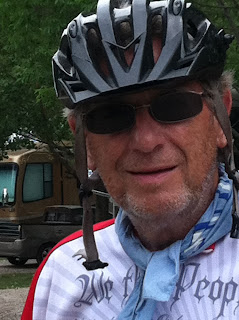The first tour was to La Paz and Lake Titicaca, including Puno, Peru. We visited Copacabana and the Island of the Sun on the Bolivian side of Lake Titicaca, and then the floating islands of the Uros Indians and Taquile Island on the Peruvian side, both of which were extraordinary, particularly the floating islands.
On the road to Titicaca with friends Steve and Pat Felice
Barbara and Harold with Copacabana and Lake Titicaca in the background
The Basilica in Copacabana to which thousands of piligramigses take place each year.
The Floating Islands of the Uros Indians
Floating Islands of the Uros in Lake Titicaca, one of the most memorable experiences in all of our travels.. About 2000 people live on these 100+ small floating islands which are made out of the totora reeds that grow freely in Lake Titicaca. They live in primatively built small homes with thatched roofs and spend their lives keeping up their totora islands and homes, fishing, hunting and making tourist items for visitors who seem to number in the hundreds each day. They have lived isolated on these islands for hundreds of years. Their children attend school through middle school on the islands, then go to Puno (about a half hour away by boat) for high school. The young people are gradually migrating to the mainland and the easier life there. In 50 years, these islands, if they continue will simply be a museum.
A typical totora reed boat made by the Uros. These boats only last for about 8 months, because the totora reeds become waterlogged and rot.
This island is known as the Fish island. Each island has its own name.
A lookout tower on one of the islands. The modern boat is a tourist boat.
Barbara with Juana, wife of the "president" of this island, with a decorative panel we bought from her. They were extraordinarily friendly and cheerful with us.
Visit to Taquile Island
This island is about 2 1/2 hours by boat from Puno. The Indians who live here have a hardscrabble farming life. Ancient Incan farming terraces cover the island and are still used by the locals. In late Nov. it was springtime for them and they were busy preparing fields (all with hand tools) and planting.
On this walkway they are building from one end of the island to the other to facilitate tourism, you can see a local woman herding her sheep in front of us.
We hiked on the island to a small village where the locals greeted us with music and insisted we all dance with them. Harold was accompanied by a particularly enthusiastic older woman who held his hand as they danced.
This was the table they set for our dinner. The meal included a fry bread, Lake Titicaca trout, salad, yucca, and a local herb tea. Delicious.
After lunch, about 8 local families waited for us on the patio to show us their weavings and knitted work. The men in this community do the knitting, including the special hats they all wear indicating whether they are married or single, and if the latter whether they are engaged or still looking, or too young for girls! Their custom is that once a man and woman choose to become engaged, they live together for a year to decide whether or not they are actually compatible, because there is no divorce on this island. When they marry, it entails a 7-day celebration.
Re: the families with items for sale, our guide encouraged us not to buy everything from just one family. In fact, between the Felices and ourselves, we ended up buying from every family. One we accidentally left out made sure we knew they were the only family not bought from. Yes, we bought from them, too. Their weavings and knittings have actually won international prizes for indigenous work.
On the Mamoré River on the boat, Reina de Enin
The Reina de Enin, tied up for the night. We spent three days and four nights on this boat, cruising the river with jungle on all sides, seeing monkeys and pink sweet water dolphins unique to this river, seeing the elusive blue morph butterfly and numerous exotic birds. The temperatures were in the mid nineties and so was the humidity! No air conditioning, but with fans and good ventilation we still slept well at night. Despite the heat, the surroundings were adventurous and the accommodations were adequate. (Ever had a shower positioned so that the whole tiny bathroom took a shower along with you? With river water?) We had a wonderful time for those four days.
The dining room on the Enin where we were entertained one evening and morning by this duo that played and sang delightful music. The food was a daily highlight, very good.
One of our activities was a horseback ride through some wetlands and the jungle. Here's Harold on his horse.
Our long-time friends from Santa Cruz, Kelly and David Boldt and their teenage daughter, Julia, accompanied us on this trip. Here, they chill out in the bow of a small boat we took on a late-afternoon ride up the river one day.
These were our hosts, Victor and Barbara. Barbara was the captain of the ship, a garrulous interesting woman's woman in her early 40s who grew up in Belgium and speaks about five languages. She is married to Victor, a Bolivian 11 years her junior. Becoming acquainted with her added a lot to the exotic nature of the trip.

.JPG)
.JPG)
.JPG)
.JPG)
.JPG)
.JPG)

.JPG)
.JPG)
.JPG)
.JPG)
.JPG)
.JPG)
.JPG)



.JPG)
.JPG)
.JPG)
.JPG)
.JPG)
.JPG)
.JPG)
.JPG)
.JPG)
.JPG)
.JPG)
.JPG)
,+Ouray+(1).JPG)
.JPG)
.JPG)
.JPG)






.JPG)

.JPG)
.JPG)
.JPG)
.JPG)
.JPG)
.JPG)

.JPG)



.JPG)

